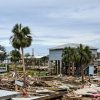As Typhoon Doksuri ravaged through China’s capital, Beijing, on Monday, two people were found unresponsive in a river in Mentougou, a district in west Beijing that bore the brunt of the severe flooding. According to reports, more than 31,000 people had already evacuated their homes, forced to leave behind their daily routines due to the torrential rain.
Heavy rain continued to pour down on Beijing, along with Hebei, Tianjin, and eastern Shanxi, as Doksuri slowly dissipated over northern China. The storm, one of the strongest to hit China in recent years, had earlier wreaked havoc in the southern province of Fujian, displacing hundreds of thousands of people from their homes.
The rainfall in Beijing was nothing short of extraordinary, with average rainfall of 176.9mm between 8pm on Saturday and 1pm on Monday. In some areas of Mentougou, the rainfall reached an astonishing 580.9mm. The city’s observatory reported that the 65-mile-long Fengsha railway line, which connects west Beijing’s Fengtai district with Shacheng in Hebei, had suffered significant water damage, disrupting travel plans for nearly 2,000 passengers and railway crew.
Meanwhile, Beijing Traffic Radio reported that all construction activities were halted on over 4,000 construction sites, with more than 20,000 buildings inspected for damage. Scenic spots in the city were also closed, rendering popular tourist destinations inaccessible.

As the city struggled to come to terms with the extent of the damage caused by Doksuri, authorities were already bracing themselves for the impending arrival of Typhoon Khanun, which was expected to strike China’s densely populated coast this week. With Khanun set to inflict further damage on crops already ravaged by Doksuri, the city’s residents were left with a sense of uncertainty and anxiety.
For those who had already been affected by Doksuri, social media posts showed harrowing scenes of emergency workers battling to clear fallen trees and landslides, and people wading through thigh-high flood waters, desperate to reach higher ground. Just days before, Doksuri had made landfall in Fujian, downing power lines, uprooting trees, and affecting over 880,000 people, forcing more than 354,400 to evacuate and resettle, and causing over 478 million yuan (approximately £52 million) in direct economic losses.
Before reaching China, Doksuri had ripped through Taiwan and the northern Philippines, where strong winds and rain led to the capsizing of a ferry, claiming the lives of at least 25 people. As the people of Beijing began the long and arduous process of rebuilding and recovering, there was little doubt that Doksuri would be remembered as one of the most destructive storms to hit the city.

